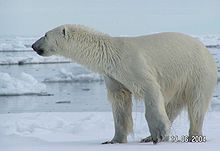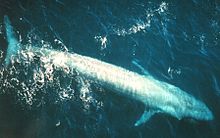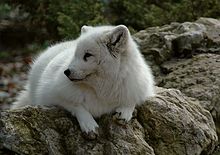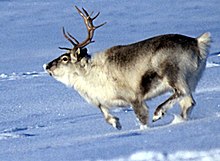List of mammals of Svalbard and Jan Mayen

This is a list of mammal species recorded in Svalbard and Jan Mayen. There are seventeen mammal species in Svalbard and Jan Mayen, of which three are endangered and three are vulnerable.[1]
The following tags are used to highlight each species' conservation status as assessed by the International Union for Conservation of Nature:
| EX | Extinct | No reasonable doubt that the last individual has died. |
| EW | Extinct in the wild | Known only to survive in captivity or as a naturalized populations well outside its previous range. |
| CR | Critically endangered | The species is in imminent risk of extinction in the wild. |
| EN | Endangered | The species is facing an extremely high risk of extinction in the wild. |
| VU | Vulnerable | The species is facing a high risk of extinction in the wild. |
| NT | Near threatened | The species does not meet any of the criteria that would categorise it as risking extinction but it is likely to do so in the future. |
| LC | Least concern | There are no current identifiable risks to the species. |
| DD | Data deficient | There is inadequate information to make an assessment of the risks to this species. |

Rodents make up the largest order of mammals, with over 40 percent of mammalian species. They have two incisors in the upper and lower jaw which grow continually and must be kept short by gnawing.
- Suborder: Sciurognathi
- Family: Cricetidae
- Subfamily: Arvicolinae
- Genus: Microtus
- Southern vole, Microtus levis LC introduced
- Genus: Microtus
- Subfamily: Arvicolinae
- Family: Cricetidae
Order: Lagomorpha (rabbits, hares and pikas)
[edit]
The lagomorphs comprise two families, Leporidae (hares and rabbits), and Ochotonidae (pikas). Though they can resemble rodents, and were classified as a superfamily in that order until the early 20th century, they have since been considered a separate order. They differ from rodents in a number of physical characteristics, such as having four incisors in the upper jaw rather than two.
- Family: Leporidae (rabbits, hares)
- Genus: Lepus
- Mountain hare, L. timidus LC introduced
- Genus: Lepus


The order Cetacea includes whales, dolphins and porpoises. They are the mammals most fully adapted to aquatic life with a spindle-shaped nearly hairless body, protected by a thick layer of blubber, and forelimbs and tail modified to provide propulsion underwater.
- Suborder: Mysticeti
- Family: Balaenidae (right whales)
- Genus: Balaena
- Bowhead whale, Balaena mysticetus EN
- Genus: Eubalaena
- North Atlantic right whale, Eubalaena glacialis CR
- Genus: Balaena
- Family: Balaenopteridae (rorquals)
- Subfamily: Balaenopterinae
- Genus: Balaenoptera
- Minke whale, Balaenoptera acutorostrata LC
- Blue whale, Balaenoptera musculus EN
- Fin whale, Balaenoptera physalus EN
- Genus: Balaenoptera
- Subfamily: Megapterinae
- Genus: Megaptera
- Humpback whale, Megaptera novaeangliae LC
- Genus: Megaptera
- Subfamily: Balaenopterinae
- Family: Balaenidae (right whales)
- Suborder: Odontoceti
- Superfamily: Delphinoidea
- Family: Delphinidae (marine dolphins)
- Genus: Lagenorhynchus
- White-beaked dolphin, Lagenorhynchus albirostris LC
- Genus: Leucopleurus
- Atlantic white-sided dolphin, Leucopleurus acutus LC
- Genus: Orcinus
- Killer whale, Orcinus orca DD
- Genus: Lagenorhynchus
- Family: Monodontidae (narwhal and beluga)
- Genus: Monodon
- Narwhal, Monodon monoceros LC
- Genus: Delphinapterus
- Beluga, Delphinapterus leucas LC
- Genus: Monodon
- Family: Ziphiidae (beaked whales)
- Subfamily: Hyperoodontinae
- Genus: Hyperoodon
- Northern bottlenose whale, Hyperoodon ampullatus DD
- Genus: Hyperoodon
- Subfamily: Hyperoodontinae
- Family: Delphinidae (marine dolphins)
- Superfamily: Delphinoidea


There are over 260 species of carnivorans, the majority of which feed primarily on meat. They have a characteristic skull shape and dentition.
- Suborder: Caniformia
- Family: Canidae (dogs, foxes)
- Genus: Vulpes
- Arctic fox, Vulpes lagopus LC
- Genus: Vulpes
- Family: Ursidae (bears)
- Genus: Ursus
- Polar bear, Ursus maritimus VU
- Genus: Ursus
- Family: Odobenidae
- Family: Phocidae (earless seals)
- Genus: Cystophora
- Hooded seal, Cystophora cristata VU
- Genus: Erignathus
- Bearded seal, Erignathus barbatus LC
- Genus: Pagophilus
- Harp seal, Pagophilus groenlandicus LC
- Genus: Phoca
- Harbor seal, Phoca vitulina LC
- Genus: Pusa
- Ringed seal, Pusa hispida LC
- Genus: Cystophora
- Family: Canidae (dogs, foxes)
Order: Artiodactyla (even-toed ungulates)
[edit]
The even-toed ungulates are ungulates whose weight is borne about equally by the third and fourth toes, rather than mostly or entirely by the third as in perissodactyls. There are about 220 artiodactyl species, including many that are of great economic importance to humans.
- Family: Bovidae (cattle, antelope, sheep, goats)
- Family: Cervidae (deer)
- Subfamily: Capreolinae
- Genus: Rangifer
- Reindeer, R. tarandus VU
- Svalbard reindeer, R. t. platyrhynchus
- Reindeer, R. tarandus VU
- Genus: Rangifer
- Subfamily: Capreolinae
See also
[edit]- List of chordate orders
- Lists of mammals by region
- List of prehistoric mammals
- Mammal classification
- List of mammals described in the 2000s
Notes
[edit]- ^ This list is derived from the IUCN Red List which lists species of mammals and includes those mammals that have recently been classified as extinct (since 1500 AD). The taxonomy and naming of the individual species is based on those used in existing Wikipedia articles as of 21 May 2007 and supplemented by the common names and taxonomy from the IUCN, Smithsonian Institution, or University of Michigan where no Wikipedia article was available.
References
[edit]- "The IUCN Red List of Threatened Species: Mammals of Svalbard and Jan Mayen". IUCN. 2001. Retrieved 22 May 2007. [dead link]
- "Mammal Species of the World". Smithsonian National Museum of Natural History. 2005. Archived from the original on 27 April 2007. Retrieved 22 May 2007.
- "Animal Diversity Web". University of Michigan Museum of Zoology. 1995–2006. Retrieved 22 May 2007.
- Aulagnier, S. et al. (2008) Guide des mammifères d'Europe, d'Afrique du Nord et de Moyen-Orient. Delachaux et Niestlé, Paris
- Shirihai, H. & Jarrett, B. (2006) Whales, Dolphins and Seals: A Field Guide to the Marine Mammals of the World. A & C Black, London
